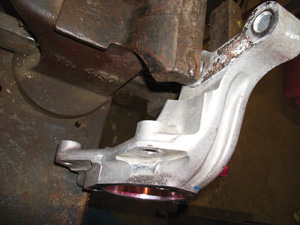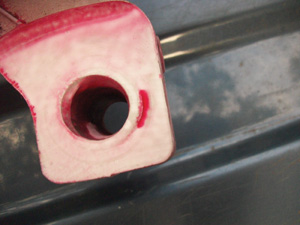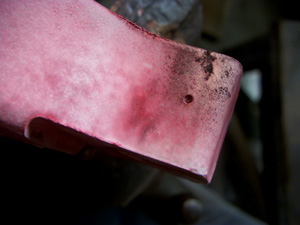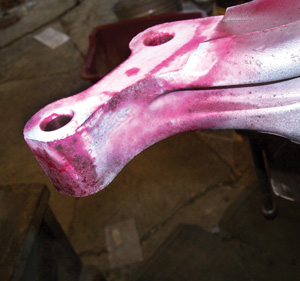


 When I woke up one recent morning, I was trying to figure out how I could magically catch everyone’s interest in developing a new profit center to help their businesses. Then, I realized I wasn’t fully awake. Of course, some will resist new things even when they’re profitable (a bad word to some in the business). Others will shrug and say, “Oh, they’ll never pay for that.” But before you respond this way, please consider if you’ve tried asking the right way.
When I woke up one recent morning, I was trying to figure out how I could magically catch everyone’s interest in developing a new profit center to help their businesses. Then, I realized I wasn’t fully awake. Of course, some will resist new things even when they’re profitable (a bad word to some in the business). Others will shrug and say, “Oh, they’ll never pay for that.” But before you respond this way, please consider if you’ve tried asking the right way.
Dye checking and magnaflux procedures are required in many industries and should be in the collision repair industry as well. Dye checking may seem complicated, but it’s actually an easy operation and requires a relatively small capital investment. It’s basically the process of preparing a part by cleaning it, spraying it with a special penetrate followed by a developer, and finally inspecting it under a black (ultraviolet) light. Small, non-visible stress cracks and fractures will show up in the inspection if present.
Magnafluxing is an advanced procedure that uses strong magnetic fields to test the structural integrity of metals, especially iron and iron-based alloys. It can reveal even microscopic flaws in the surface structure of metals, and therefore is used to check the quality of a variety of metal parts, pieces and tools.
Magnetic Flux
Magnafluxing consists of subjecting the entire structure of the metal to be tested to a strong magnetic field. At the point of imperfections, or the line of seams in the metal, the flaws will cause disturbances in the magnetic field called “magnetic flux.” The observation of magnetic flux during magnafluxing is the key indication of a problem.
Most magnafluxing procedures use iron oxide to coat the surface of the metal being tested. Disturbances of magnetic flux are visible by the reaction of the iron oxide that coats the surface at the points of the greatest magnetic flux, with the aid of a black light. In effect, the iron oxide gathers to the point of the imperfections, attracted by the magnetic flux.
Magnafluxing can be performed in either wet or dry conditions. In dry conditions, the iron oxide is in the form of a fine powder, like dust, which is scattered over the part. In wet conditions, a liquid solution of iron oxide is used instead to coat the entire surface of the metal before subjecting it to a high-energy magnetic field.
Magnafluxing is most commonly used on iron and iron-based alloys, most prominently on steel. It can also be used on other elements and elemental alloys, including nickel and cobalt. The magnafluxing procedures for different elemental bases and different alloys aren’t significantly different.
Cause for Concern
Why should repairers be concerned? Many insurers are pushing for the use of recyclable structural and suspension parts. The statement I’ve heard is, “Look! Those steel and aluminum suspension parts don’t easily wear out, and if they don’t look undamaged, then don’t use them.” But it would be unconscionable for a repairer to believe that a pair of eyes, no matter how good, could tell that a part is usable through a process as simple as visual inspection when the flaw could exist at the molecular or microscopic level only. It’s also just as great of an error for any insurance company to believe this statement.
I spent many years building racecars and motors and found that what looks good to the eye may not be so good when properly tested. Many repairers are in the racing business in one form or another, fly airplanes or partake in a pastime where safety is stressed. Trust the magnaflux or dye penetrate tests. They’re better than eyes.
Escalating Repair Costs
Okay, conducting these tests is not a new concept – they’ve been around for years and even decades. But they’re new as far as considering them in the collision repair industry. Even a few mechanical repairers have learned their value in determining the integrity of parts considered for use. To explain why I think these processes are important, I must address some issues collision repairers currently facing.
The cost of repairs continues to escalate daily, which means the industry is repairing fewer vehicles, especially the lower value/older models. We have more accident avoidance systems to contend with on expensive models, along with other safety measures, which equate to lower loss frequency for insurers. So our market share of repairable vehicles is declining rapidly.
The question as it relates to this article is, “Why add a cost that could be a tipping point on whether a vehicle is repairable?” To answer that question, the repairer and even the insurer should look at the cost and exposure of an improperly repaired vehicle against the peace of mind of a properly and safely prepared one. Maybe I believe in the Tooth Fairy, but I would rather stake my business on the latter.
Protect Yourself
I may have lost a few of you when I mentioned used suspension parts. As an appraisal company owner, I wouldn’t allow my people to figure for any used front suspension parts. Neither I nor my E&O carrier would want to carry the liability associated with doing that.
The only way used suspension parts or remanufactured wheels should be considered is if the vendor guarantees that they’ve been at the minimum dye checked and preferably magnafluxed on steel or iron parts. If they haven’t, you as the repairer are accepting tremendous liability by installing them without checking them for usability and replacing any wearable parts such as bushings or ball joints.
Remember, it has been said that the repairer is the final expert on parts and procedures. From a liability standpoint, it’s you and your garagekeeper’s liability that’s going to take the hit.
If the repairer is required to use these parts, for his or her own protection, a standard operating procedure should be a dye check on parts or magnaflux examination on ferrous parts. This takes shop time and manpower and is an operation not listed in any of the information providers’ systems, so you’re entitled to be paid for it. Remember, the information providers all say that their information is a guide and not meant to be inclusive and that certain items must be left to the judgment of the estimator at inspection.
The operation may also need to be performed on some suspension parts of the damaged vehicle that are being reused and have sustained impact. Such was the case of the spindle shown on pg. 38. Many times, we also don’t think of parts which look useable away from the point of impact but which may comprise secondary damage if the vehicle has hit a curb on the side opposite from the impact. A damaged wheel or a blown tire on the off side should raise flags and be treated as sustained damage until shown differently. If a tire or wheel shows evidence of curb impact, then the entire suspension or strut assembly should be carefully checked for structural integrity before reuse.
If supplements are turned down on suspected damaged suspension parts, this is also one way of showing that a repairer is only asking for what should be reasonable anyway. This verification shouldn’t be a freebie because it’s not included anywhere in the procedure.
Wheels, particularly cast aluminum, forged aluminum and alloy, may be subject to cracks which can’t be visibly seen but which could cause safety concerns. These may be wheels that were on the vehicle, used wheels or remanufactured wheels. I’ve only heard of one remanufacturer that claims it dye checks its products – and it’s only wheels that have visible cracks. If they’re visible, why check them with dye and then rebuild and sell them?
I do have a war story out of Texas where a remanufactured wheel was used in a repair, and the owner drove the vehicle home and the wheel blew out while it was setting on his drive. Would checking have made a difference? I hope it would have, because I have a photo of the replacement wheel that wasn’t used.
A Business Decision
My point isn’t to say whether used suspension parts should or shouldn’t be used. It’s the shop’s decision, made along with (we hope) the vehicle owner’s approval. The shop should, however, take every precaution it can to verify the parts are safe to use. If it performs processes which aren’t included in known databases, it should be paid for those processes. Why would any insurer, if it’s truly concerned about the vehicle owner’s safety, object to the testing of a product that ensures the safety of the part it requested be used?
I won’t mention any figures, but I would hazard a guess that most shops could more than pay the light and gas bill for the year with this profit center. Is anyone interested? This would be in addition to protecting their businesses, customers and the person with the deepest pocket in the crowd: the insurer. It’s simply a smart and justified best business practice. As with anything else you do, charge for it. But if you don’t do it, don’t charge for it.













